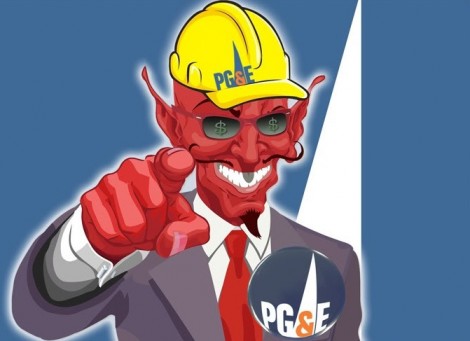 Why have I asked if PG&E is now like the stormy, long-term renter you somehow invited into your rental house years ago but, now, because you’ve recently found out that they’ve managed to destroy a good portion of your property, the neighbors are complaining and your property values are subsequently plummeting — you’ve got to get them out?
Why have I asked if PG&E is now like the stormy, long-term renter you somehow invited into your rental house years ago but, now, because you’ve recently found out that they’ve managed to destroy a good portion of your property, the neighbors are complaining and your property values are subsequently plummeting — you’ve got to get them out?
Because PG&E, I’m positing, may be acting like those bad tenants right now. By destroying your house and your property values. Purposely and with knowledge of their actions.
If you’ve been a landlord or you know one, you realize what I’m talking about. The tenants that, upon receiving the eviction notice, decide to punch holes in your walls, steal your appliances, rip down doors, break windows and then leave because, after all, they can’t be in your house any more.
So if you’re kicking them out, boy are you gonna pay!
 PG&E doesn’t really like its customers any more because they’ve had the temerity to try to sue for 85+ deaths — a feat they won’t yet be able to accomplish as PG&E filed for Chapter 11 bankruptcy in January of this year (the largest utility bankruptcy in US history), facing $30 billion dollars in wildfire liability — so PG&E (never faced with such animus before in its corporate life) has decided to, as it begins to exit, rip your house apart. Because it can.
PG&E doesn’t really like its customers any more because they’ve had the temerity to try to sue for 85+ deaths — a feat they won’t yet be able to accomplish as PG&E filed for Chapter 11 bankruptcy in January of this year (the largest utility bankruptcy in US history), facing $30 billion dollars in wildfire liability — so PG&E (never faced with such animus before in its corporate life) has decided to, as it begins to exit, rip your house apart. Because it can.
How? By cutting off your power whenever the hell it feels like it under the guise of “we’re just helping you avoid wildfires.” Except that, yeah, that’s not working either.
Have you ever heard another utility say “in order to save you from electricity, we’re going to have to cut your electricity”? It would be similar to saying “in order to save you from water, we’re going to cut off your water.” Or your air, if they could.
And oh yes, they’re cutting off power to areas that aren’t really subject to wildfires. But PG&E doesn’t care. It’s going to shit on your bed for as long as you allow it to.
Meanwhile, back at the ranch, its managers and CEOs are having a wonderful time at your expense. And they’re really enjoying watching you suffer. What fun! More champagne!
As Fires Ravaged California, Utilities Lobbied Lawmakers for Protection
by Ivan Penn, 1-5-19
LOS ANGELES — As California’s deadliest wildfire was consuming the town of Paradise in November, some of the state’s top power company officials and a dozen legislators were at an annual retreat at the Fairmont Kea Lani resort on Maui. In the course of four days, they discussed wildfires — and how much responsibility the utilities deserve for the devastation, if any.
If any. Pass the Laphroaig! Great luau! More rotisserie pig! More leis!
But get this:
It is an issue of increasing urgency as more fires are traced to equipment owned by California’s investor-owned utilities. The largest, Pacific Gas and Electric, could ultimately have to pay homeowners and others an estimated $30 billion for causing fires over the last two years. The most devastating of those, the Camp Fire, destroyed thousands of homes in Paradise and killed at least 86 people.
Realizing that their potential fire liability is large enough to bankrupt them, the utility companies are spending tens of millions of dollars on lobbying and campaign contributions. Their goal: a California law that would allow them to pass on the cost of wildfires to their customers in the form of higher electricity rates. After an earlier lobbying push, legislators have already voted to protect the companies from having to bear the cost of 2017 fires, and utilities are seeking the same for 2018.
What a great world that would be! Feed the pig! Pass the pig!
But public interest groups say the utilities are effectively seeking a bailout for mistakes made by well-compensated executives. The utilities have been frequently criticized, for example, for not trimming trees along power lines. Some policy experts and lawmakers say it might be better to break up PG&E, replace its board and management or convert it into a publicly owned utility.
Uh oh. This doesn’t sound good. But that wouldn’t hurt customers, would it?
People on both sides fear that the state, which prides itself on being a leader in the fight against climate change, could be on the cusp of an energy crisis — its second in less than two decades. In 2000 and 2001, California was roiled by blackouts, soaring electricity rates and the bankruptcy of PG&E after the state made missteps in deregulating the power industry.
Energy crisis? Again? Hold that thought. Did you folks know this:
Just two months before the Camp Fire, PG&E seemed to have solved its most pressing problem: protecting its shareholders from footing the bill for the 2017 wildfires. On the typical bill of $100 a month, the company estimates, a customer would pay an additional $5 for every $1 billion the utility borrowed to cover damages.
Perfect. Ratepayers footing the bill for the homicidal PG&E’s incompetence.
The companies waged a multimillion-dollar campaign to secure that protection. In the first nine months of 2018, the three investor-owned utilities collectively gave $5 million to the campaigns of state lawmakers, as much as $1 million more than they had in any full year since 2011, according to Consumer Watchdog, an advocacy organization in California.
That’s cash that should have gone to the customers and the people injured or killed.
PG&E stepped up its lobbying effort, too — spending $8.4 million in just the first nine months of 2018, compared with $1.6 million in all of 2017 and $1.1 million in 2016. The company’s spending in the first three quarters exceeded 2017’s top spender, Chevron, which spent $8.2 million that year, according to Consumer Watchdog.
“Money talks in Sacramento, and big money talks loud enough to buy a big bailout,” said Jamie Court, president of Consumer Watchdog. “There is no legislator of either party, even those who don’t take money from the utilities, who doesn’t worry about bucking the utilities.”
Consumer groups say the efforts to protect utilities are particularly galling because Californians already pay more for power than people in other Western states. The state’s residential electricity prices are between 19 percent and 40 percent higher than in neighboring Arizona, Nevada and Oregon.
Remember I mentioned another Kalifornia energy crisis? Keep reading.
For starters, PG&E was one of the prime backers of the catastrophic law that deregulated California’s energy sector, which led to rampant fraud, manipulation and speculation in the electricity market by energy-trading companies like Enron, causing artificial electricity shortages, massive black-outs, 20-fold increases in electricity rates and, ultimately, to PG&E’s own bankruptcy.
That didn’t go well. I was here. Rolling brownouts in the summer and skyrocketing rates.
Instead of letting the deregulated market do its magic and let a more competitive company step in, PG&E lobbied California’s pliable legislators for a 40% rate increase and two rounds of bailouts that came to a total of $16 billion, courtesy of PG&E customers. In fact, the utility’s 5 million ratepayers are still paying for the company’s mistakes through mandatory fees. By the time PG&E’s bankruptcy-related debts are paid off in 2012, ratepayers will each have dished out around $1,500 to keep it from collapsing.
Whoa, us lucky Kalifornians! But was it a real crisis in 2001? No, of course not. Listen:
But how is PG&E acting like bad renters?
Because they realize that shutting off your power hurts you personally and sometimes physically, and they know that the process of de-energizing the lines and re-energizing the lines and the concomitant neglected equipment is having a deleterious effect on all the infrastructure.
Transformers, high voltage power lines and associated heavy electrical equipment is designed, as you would suspect on any average electrical grid, to work constantly and dependably. It was designed to take high loads, some occasional power spikes and the occasional outage when lines break and power is diverted.
It wasn’t designed to be started and stopped like the engine on your car.
None of it was engineered to be de-energized and then re-energized with any kind of regular frequency. That’s not the job of that equipment. Its job is to carry big voltage. You recall how PG&E has consistently made something of a “big deal” about re-energizing its equipment and the subsequent checks they must make prior to restoring power? Apparently there is an excellent reason for that.
Because this easily-ignored and likely bypassed tidbit exists six paragraphs down:
PG&E said inspectors found 55 instances of damage to their equipment statewide.
PG&E “inspectors.” People whose job it is to monitor lines and apparatus following de-energization. Does PG&E know — or do other electrical equipment and transformer manufacturers know — what kind of damage is done when you place such stress on these systems under these circumstances with, now, regularity?
I think I could make an excellent argument for saying there is an even greater stress being placed on PG&E lines and equipment already in questionable shape by bringing the system up and down — to the point where one must ask: is doing this jeopardizing customers with an even greater risk of arcing, flashing and resulting wildfires?
Smart people will want to have answers to those questions.
And smart people will realize that the PG&E management recognizes its days are numbered, that they’re soon to be torn apart and thrown to the wolves. So fuck it. If they can’t have their bloated-pig PG&E, then you won’t have it either.
I can hear the sound of holes being kicked in drywall from here.
BZ


NO question this is going to get ugly quickly. And I don’t see a good answer going forward. 10 years to ‘fix’ the problem? WTF???
It’s the “new normal” in Kalifornia. People aren’t listening to what PG&E and others are saying. Kalifornia is officially a Third World Country featuring Blood Technology. It’s the Blood Technology and those supporting it that are making boatloads of kash in Kalifornia. Everyone else is a pauper living in the shit-and-piss ridden gutters.
BZ